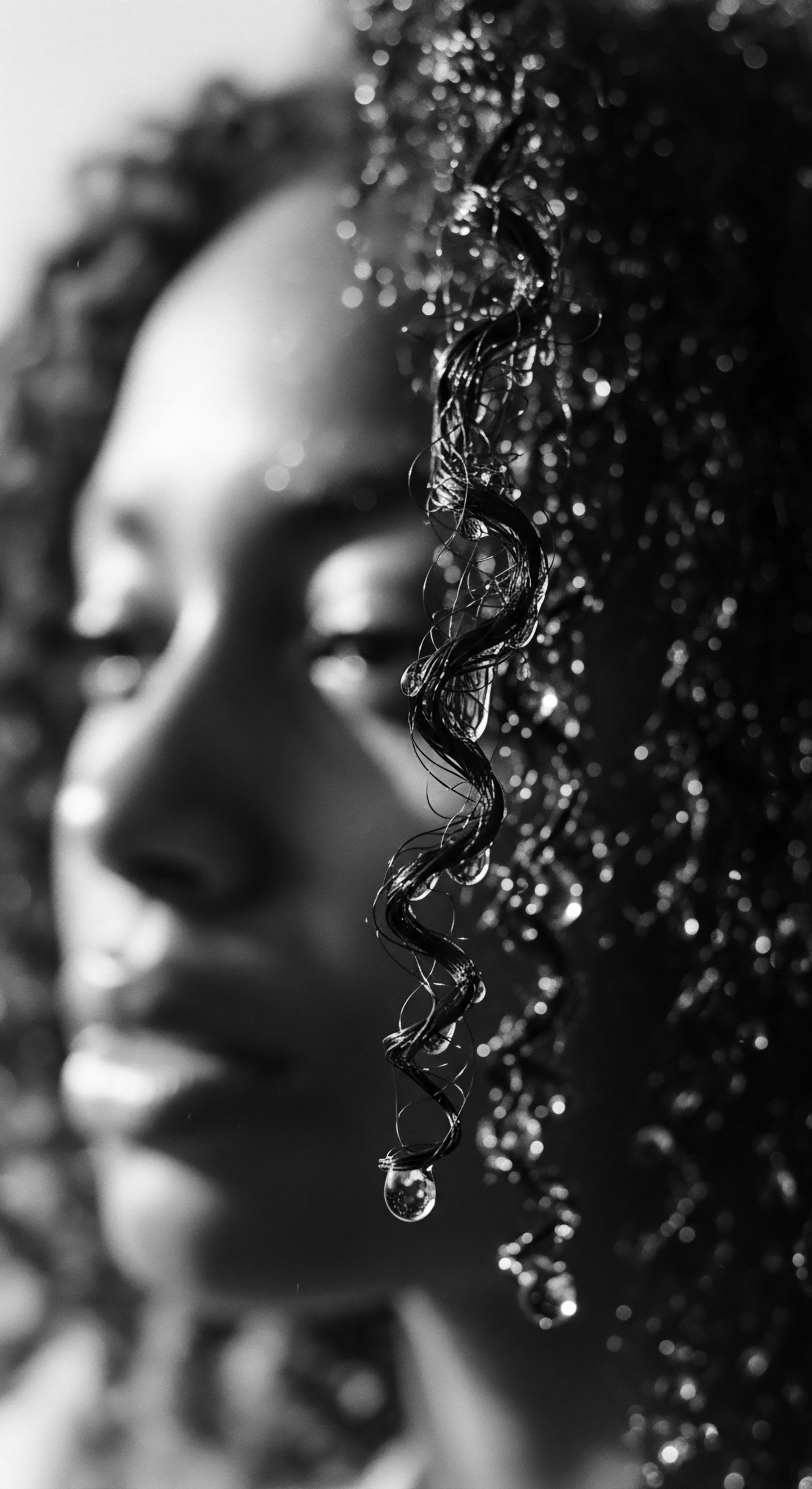
Fundamentals
The exploration of Hydration Strategies, particularly as they pertain to the majestic landscape of textured hair, compels us to delve into the very fabric of moisture. To understand Hydration Strategies is to grasp the profound significance of water—its presence, its retention, and its sustained integration within the hair strand—for health, vitality, and aesthetic integrity. This is not a mere application of liquid; it constitutes a deliberate, ancestral dance with elements to coax life and resilience into curls, coils, and waves.
At its fundamental interpretation, a Hydration Strategy refers to the intentional and systematic methods employed to introduce and preserve water molecules within the hair’s keratin structure. This involves a spectrum of practices, from the simplest act of wetting hair to the complex layering of products that serve to draw in water, bind it within the hair shaft, and subsequently seal it against the evaporative forces of the environment. The meaning of such strategies deepens when one considers the unique architecture of textured hair, which, due to its varied curl patterns and often raised cuticle, can be more prone to moisture loss than straighter hair types.
Understanding Hydration Strategies means acknowledging the deliberate and ancestral methods for infusing and retaining water within the hair’s keratin structure, particularly vital for textured hair.
Consider the elemental truth ❉ water is the wellspring of life, and for hair, it is no less so. Without sufficient hydration, the hair strand becomes brittle, loses its elasticity, and is susceptible to breakage. The proper delineation of Hydration Strategies, therefore, addresses both the immediate replenishment of moisture and the long-term cultivation of an environment where hair can thrive. The clarification of this concept extends beyond superficial dampness; it speaks to the deep saturation of the hair’s cortex and the integrity of its external cuticle layers, all working in concert to maintain suppleness and strength.

The Water’s Whisper ❉ Early Understandings
From antiquity, communities possessing textured hair recognized the vital role of moisture. Long before the advent of modern cosmetic science, traditional practices provided a foundational understanding of what we now classify as Hydration Strategies. The ancient Egyptians, for instance, utilized intricate oiling rituals, often incorporating plant-derived oils and butters, which, while not solely about water application, served as occlusives to preserve the natural moisture already present in the hair or introduced through washes. This early wisdom demonstrates an intuitive understanding of the hair’s need for moisture protection.
Across various ancestral landscapes, the connection between hair health and moisture was observed keenly. Hair that felt dry, brittle, or lacked movement was understood to be “thirsty,” a recognition that spurred the creation of remedies from the surrounding botanical world. The very definition of hair care in these contexts was often inextricably linked to practices that either introduced water or prevented its escape.
- Plant Mucilages ❉ Early use of flaxseed, okra, or aloe vera for their gelatinous textures to provide slip and moisture.
- Natural Butters ❉ Shea butter, cocoa butter, and mango butter, prized for their emollient and occlusive properties to seal in moisture.
- Ceremonial Washes ❉ Ritualistic cleansing using natural soaps or clays, followed by rich applications of conditioning agents.
These practices, passed down through generations, formed the initial layers of what we identify today as sophisticated Hydration Strategies. The explication of these methods reveals not just practical application but a profound respect for the hair as a living entity, deserving of deliberate, moisture-sustaining attention.

Intermediate
As we move beyond the elemental acknowledgement of water’s significance, an intermediate comprehension of Hydration Strategies requires a deeper appreciation for the interplay of various agents and methods that promote sustained moisture in textured hair. This intermediate perspective recognizes that effective hydration transcends mere dampening; it involves a thoughtful sequence of steps designed to optimize water absorption, binding, and retention within the unique structural framework of coily, kinky, and wavy strands.
The core of intermediate Hydration Strategies lies in understanding the function of humectants, emollients, and occlusives. Humectants, such as glycerin or hyaluronic acid (found naturally in many plants), act as moisture magnets, drawing water from the atmosphere or from previously applied watery solutions into the hair shaft. Emollients, typically oils and butters, work to smooth the hair’s surface, reducing friction and enhancing pliability.
Occlusives, often heavier oils, butters, or waxes, form a protective barrier on the hair surface, preventing water from evaporating. The precise interpretation of Hydration Strategies involves harmonizing these elements to create a micro-environment conducive to sustained moisture.
Intermediate Hydration Strategies involve a deliberate sequence of humectants, emollients, and occlusives, recognizing textured hair’s unique structural needs for optimal moisture absorption and retention.
The delineation of effective intermediate strategies often brings to light the concept of layering—applying products in a specific order to maximize their efficacy. This layering might commence with a water-based product or a humectant-rich leave-in conditioner, followed by a lighter oil or cream, and concluding with a heavier butter or oil to seal the moisture. This systematic application enhances the hair’s ability to remain supple and resilient between wash days. Such practices are not solely modern inventions; their prototypes are deeply ingrained in ancestral traditions.

The Tender Thread ❉ Ancestral Ingenuity in Moisture Preservation
For generations, Black and mixed-race communities, particularly those in the diaspora, have developed complex and often intuitive hydration practices that mirror, in principle, modern scientific understandings. The historical context of hair care within these communities is steeped in a legacy of resourcefulness and a deep respect for hair as a sacred symbol of identity and resilience. The challenges posed by forced migration, chattel slavery, and subsequent economic hardship necessitated the development of inventive methods to preserve hair health with limited resources, reinforcing the critical role of hydration.
Consider the profound role of traditional hair oiling practices, a practice that has spanned continents and centuries. In West Africa, the consistent application of locally sourced oils and butters, often infused with herbs, served as a primary Hydration Strategy. These oils were not just for sheen; they were a vital component of moisture retention.
One potent example is the widespread and enduring use of shea butter (karité) . Derived from the nuts of the shea tree, its application was a ceremonial and practical act, sealing moisture into hair that was regularly washed or exposed to harsh climates.
During the transatlantic slave trade and the subsequent establishment of plantations, access to traditional ingredients was often curtailed. Yet, enslaved Africans and their descendants demonstrated an extraordinary capacity for adaptation. They utilized available resources—animal fats, plant-derived oils, and even kitchen scraps—to create substitutes for their ancestral hair care products.
These ingenious adaptations underscored the fundamental understanding that protective measures were needed to preserve hair’s moisture and integrity, which was crucial for preventing breakage under grueling conditions. The practice of “greasing” the scalp and hair, often misinterpreted as simply applying oil, was, at its heart, an ancestral Hydration Strategy, aiming to seal in the body’s natural moisture and whatever little external moisture could be introduced.
| Category Humectants |
| Ancestral Agent/Practice Okra mucilage, Aloe Vera sap |
| Modern Parallel/Principle Glycerin, Hyaluronic Acid |
| Category Emollients |
| Ancestral Agent/Practice Palm oil, Castor oil, Coconut oil |
| Modern Parallel/Principle Cetyl alcohol, Fatty acids, Silicones |
| Category Occlusives |
| Ancestral Agent/Practice Shea butter, Cocoa butter, Animal fats |
| Modern Parallel/Principle Petrolatum, Mineral oil, Heavier plant waxes |
| Category Application Method |
| Ancestral Agent/Practice Sectioning, Braiding for retention |
| Modern Parallel/Principle L.O.C. (Liquid, Oil, Cream) Method, Protective Styling |
| Category The legacy of ancestral practices continues to inform contemporary approaches to textured hair hydration, demonstrating enduring wisdom. |
The persistence of communal hair care rituals—the sharing of knowledge between mothers, aunts, and sisters—further solidified these strategies. Hair washing, detangling, and oiling sessions were not only about physical care but also about transmitting knowledge, reinforcing community bonds, and maintaining a connection to heritage. These communal gatherings, rich with storytelling and shared wisdom, ensured that the lessons of moisture preservation were passed down, shaping the collective understanding of hair health.
The resilience inherent in these historical Hydration Strategies is a profound testament to the ingenuity of Black and mixed-race people. In environments often hostile to their very existence, the consistent care of hair, including its hydration, became an act of self-preservation and cultural affirmation. This historical thread undeniably enriches our contemporary understanding of what it means to truly hydrate textured hair.

Academic
The academic investigation into Hydration Strategies transcends practical application, seeking a comprehensive understanding of its meaning and significance within the intricate biophysics of textured hair and its profound socio-cultural implications. From an academic vantage, Hydration Strategies represent a complex interplay of molecular science, structural mechanics, environmental factors, and historical human adaptation. The precise meaning here encompasses the entire ecosystem of practices, products, and environmental considerations that contribute to the hair fiber’s optimal water content and mechanical integrity. This advanced perspective requires a deep, research-backed examination, particularly through the lens of Black and mixed-race hair experiences, which have often been marginalized in mainstream scientific discourse.
The fundamental challenge for textured hair in maintaining hydration lies in its unique helical structure and often elevated cuticle layer. Unlike straight hair, the coils and curves of textured strands create multiple points where the cuticle can lift, allowing water to escape more readily and making it harder for natural oils (sebum) to travel down the shaft uniformly. This architectural reality necessitates more deliberate, multi-pronged Hydration Strategies that address both the acquisition and preservation of moisture. The scientific elucidation of these strategies often focuses on the principles of osmotic gradients, hydrogen bonding, and surface tension—how water is drawn into the hair, held within the cortex, and sealed by external agents.

The Unbound Helix ❉ Biomechanics and Ancestral Resilience
From an academic perspective, understanding Hydration Strategies for textured hair begins with its fundamental biomechanics. Coily and kinky hair types possess an elliptical cross-section, and their curl patterns result in twists along the fiber axis. These points of curvature and torsion are inherent stress points, making the hair more prone to mechanical damage when dry.
Water acts as a plasticizer for keratin, increasing the hair’s elasticity and making it less susceptible to breakage during manipulation. Therefore, the strategic replenishment and maintenance of water within the hair fiber are not merely cosmetic; they are critical for maintaining structural integrity and preventing irreversible damage.
Research into the hygroscopic nature of keratin, the primary protein composing hair, reveals its capacity to absorb water from the atmosphere. However, for textured hair, this absorption often needs assistance, and critically, the absorbed water must be sealed in. This leads to the scientific backing of layering approaches that have been intuitively practiced for centuries. Humectants (like glycerin, often derived from plant sources utilized in traditional remedies) attract water.
Emollients (like fatty alcohols or plant oils) condition the outer surface, and occlusives (like heavier butters or waxes) reduce the rate of evaporative water loss. The effectiveness of ancestral practices in these realms often predates scientific validation, yet their efficacy is now being systematically affirmed.
One compelling area of study involves the resilience of hair care practices amidst historical adversity. The period of the transatlantic slave trade and plantation slavery provides a stark yet powerful case study in the evolution of Hydration Strategies. Separated from their traditional homelands and indigenous resources, enslaved Africans had to adapt.
They learned to utilize whatever was available – often animal fats, plant-based oils like palm oil, and ingenuity – to care for their hair. This wasn’t merely about appearance; hair integrity was deeply linked to health, hygiene, and a lingering connection to cultural identity in a brutal system designed to strip it away.
Academic inquiry reveals Hydration Strategies for textured hair are biomechanically vital, with water acting as a plasticizer for keratin, enhancing elasticity and preventing breakage.
For example, the consistent “greasing” of the scalp and hair, a practice passed down through generations of African Americans, was a primary strategy to manage moisture and reduce breakage in environments often lacking clean water and proper sanitation. While sometimes seen simplistically, this practice, at its sophisticated core, functioned as a protective Hydration Strategy. It created an occlusive barrier, preventing moisture loss and providing lubrication for fragile strands. The historical evidence suggests that despite immense hardship, the maintenance of hair health, often through rudimentary but effective hydration methods, was a defiant act of self-care and cultural continuity.
The long-term consequences of consistent, effective hydration extend beyond the hair fiber itself. From a psycho-social perspective, hair health significantly impacts self-esteem and identity, particularly within Black and mixed-race communities where hair has been a battleground of beauty standards and a canvas for cultural expression. The successful application of Hydration Strategies contributes to reduced breakage, promoting length retention, which has historically been a challenging aspiration for textured hair due to its fragility when dry. The ability to grow and maintain healthy, hydrated hair becomes a powerful affirmation of self and a reclamation of ancestral beauty narratives.
Moreover, the contemporary discourse surrounding Hydration Strategies also touches upon the decolonization of hair science. For too long, scientific research on hair has disproportionately focused on European hair types, leaving a significant gap in understanding the unique needs of textured hair. Academic efforts now seek to validate and elevate the ancestral wisdom inherent in traditional Black hair care practices, recognizing them not as anecdotal remedies but as sophisticated, historically refined Hydration Strategies with demonstrable efficacy. This involves researching the precise mechanisms by which traditional ingredients (like mucilages from okra or flaxseed, often overlooked in past studies) contribute to moisture retention and structural integrity in coily hair.
The application of modern analytical tools, such as electron microscopy to observe cuticle morphology and differential scanning calorimetry to assess water binding within the keratin matrix, is allowing researchers to quantify the effects of various hydration products and methods. This empirical data provides scientific corroboration for practices that have sustained generations of Black and mixed-race people. The ongoing research into the optimal ratios of humectants, emollients, and occlusives for specific textured hair types represents a continuous refinement of these strategies, building upon an ancient foundation of knowledge.
In conclusion, the academic meaning of Hydration Strategies for textured hair encompasses a deeply interconnected web of biological imperatives, historical adaptations, and cultural affirmations. It acknowledges the hair’s unique structural demands, validates the ingenious ancestral solutions, and strives to further refine these methods through rigorous scientific inquiry, always remembering the hair’s profound connection to identity and heritage.
- Cuticle Integrity ❉ Understanding how the hair’s outermost layer functions as a primary barrier to moisture loss and how hydration strategies influence its structural integrity.
- Lipid Content ❉ Examining the role of natural oils and applied lipids in creating hydrophobic barriers that prevent water evaporation from the hair shaft.
- Water Activity ❉ The study of water’s bioavailability within the hair fiber and how different humectants and environmental conditions influence this critical metric.
- Hair Elasticity ❉ Measuring the hair’s ability to stretch and return to its original state, directly correlated with its water content, to assess the effectiveness of hydration regimens.

Reflection on the Heritage of Hydration Strategies
As we close this contemplation on Hydration Strategies, we are reminded that its definition is not static, nor is it purely scientific. It is a living concept, deeply rooted in the soil of ancestral wisdom and constantly nourished by the enduring spirit of textured hair heritage. Each drop of water, each lovingly applied oil or butter, whispers stories of resilience, ingenuity, and a profound connection to the earth and its bounteous offerings. The purposeful pursuit of hydration, from the simplest spritz of water to the meticulous layering of conditioners, stands as a quiet homage to those who, through generations of care and adaptation, ensured the vibrancy of our coils and curls.
The very soul of a strand, as it were, holds the memory of countless hands tending to it, guiding it through the seasons of life, sustaining its moisture even when resources were scarce. This persistent act of care, this unwavering commitment to the hair’s well-being, is the true legacy of Hydration Strategies. It speaks to an inherited understanding that hair health is an inseparable component of holistic well-being, a visible testament to inner vitality and outer strength. In this light, Hydration Strategies are not merely techniques; they are continuations of a tender thread woven through time, connecting us to the past, grounding us in the present, and shaping the unbound helix of our future.

References
- Adeyemi, Y. (2018). African-Centred Hair Care ❉ A Cultural and Scientific Guide. Sankofa Publications.
- Chow, M. (2020). Hair in African Culture ❉ An Interdisciplinary Approach. University Press of Mississippi.
- Dawes, D. (2019). The Science of Black Hair ❉ A Comprehensive Guide to Textured Hair Care. The Hair Architect.
- Gordon, L. (2010). The History of African-American Hair ❉ From Ancient Traditions to Modern Styles. University of North Carolina Press.
- Khumalo, N. P. (2018). Hair and Scalp Disorders in People of African Descent. Springer.
- Mercer, K. (1994). Welcome to the Jungle ❉ New Positions in Cultural Studies. Routledge.
- Politi, M. (2015). The Natural Hair Handbook ❉ A Guide to Natural Hair Care and Styling. CreateSpace Independent Publishing Platform.
- Rucker, W. C. (2006). The River Flows On ❉ Black Resistance, Culture, and Identity Papers from the Zora Neale Hurston Conference. University Press of Florida.
- Saint-Louis, P. (2021). Textured Hair ❉ A Scientific and Cultural Guide. John Wiley & Sons.
- Thompson, C. (2009). Black Women and the Politics of Hair. University of Illinois Press.
